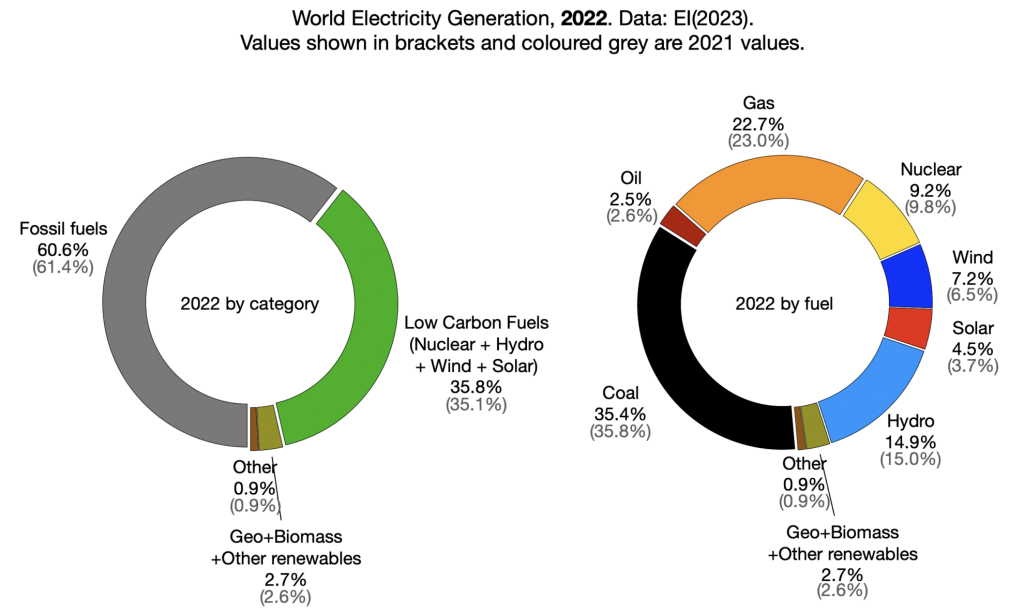By Kennedy Maize — August 15, 2023
“The historic trends contradict the conventional view that fossil generation has been declining, while renewables are gaining. According to the data, ‘The share of low carbon fuels (nuclear, hydro, wind & solar) peaked at 36% in 1995, coinciding with COP1 [the first UN conference of parties].’”
In the worldwide battle for electric generation, coal isn’t down and out. It isn’t even on the ropes. According to World Energy Data (formerly BP’s data collection report), coal is still the champ, as seen in the figure below.

In 2022, coal accounted for 35.4% of global electric generation, followed by natural gas (22.7%), hydro (14.9%), nuclear (9.2%), wind (7.2%), solar (4.5%), geothermal, biomass, and other renewables (3.6%).
The historic trends contradict the conventional view that fossil generation has been declining, while renewables are gaining. According to the data, “The share of low carbon fuels (nuclear, hydro, wind & solar) peaked at 36% in 1995, coinciding with COP1 [the first UN conference of parties].”
“Over the following 17 years, from 1996 to 2012, fossil fuels gained share, mainly due to the increased share of gas and the declining share of nuclear and hydro. As wind and solar then became significant, this trend reversed.
“Despite this, and the hosting of twenty-seven UN climate conferences, the share of electricity generation by low carbon fuels in 2022 was only roughly equivalent to the peak in 1995.”
According to the International Energy Agency (IEA) in its Coal Market Update, coal demand for power generation and steel making ”reached a new all-time high in 2022.” IEA added, “Coal trade in 2023 is heading back to 2019 volumes.”
IEA noted, “Despite lukewarm economic prospects, global supplies grew by 8% in 2022 to a record 8 634 Mt. The three largest producers – China, India, and Indonesia – each reached all-time highs in 2022. Coal production was mainly boosted by China and India, which rapidly increased domestic production to mitigate exposure to high market prices after a first price spike in October 2021.”
IEA added, “Global coal production is expected to grow further in 2023, driven by an expected strong ramp-up of production in China, India, and Indonesia in the first six months, offsetting declines in the United States and the European Union. Russian coal production is estimated to have recovered somewhat in the first half of 2023.”
In a statement accompanying its report, Paris-based IEA said that “by region, coal demand fell faster than previously expected in the first half of this year in the United States and the European Union — by 24% and 16%, respectively, However, demand from the two largest consumers, China and India, grew by over 5% during the first half, more than offsetting declines elsewhere.”
China is the coal heavyweight. Greenpeace East Asia recently reported from Beijing that China approved “At least 50.4 gigawatts (GW) of new coal power across China in the first six months of 2023.” China is also developing world-leading amounts of wind and solar generation, but Greenpeace East Asia’s Gao Yuhe said he feared the coal focus would detract from building energy storage. “We see a lot of new wind and solar and a lot of new coal. Our major concern now, aside from the obvious emissions problem, is that energy storage remains sidelined despite the key role it needs to play in the near future. Building renewable energy but no energy storage is like building wheels but no axel,” Yuhe said.
OilPrice.com commented, “China is building coal-fired power plants at a record clip as it tries to counter the effects of drought on hydropower production.” China is also the hydro heavyweight, Asia’s largest producer, “accounting for 30% of global capacity.” China “has recorded a worrying 7.2% drop in output so far this year while India, the second largest producer, has seen production decline 5%.”
OilPrice.com adds, “China is not the only country whose hydropower sector has been hit by climate change. Electricity generation from hydro power sources has fallen quite dramatically in Europe, North America and Asia in 2023 compared to the corresponding period in 2022 with overall global hydro generation now 3% below the 2019-21 average. Reduced supplies of non-emitting hydro power in these regions means that utilities are increasingly deploying other sources of dispatchable but more polluting power, such as coal and natural gas, to meet electricity demand.”
U.S. hydro from Nevada, Arizona, Washington, and Colorado has also been drought stricken, leading to a 17% decline in hydropower production.
As Forbes observes, “In the U.S., coal demand has been on a downward trend for about 15 years. There have been three significant drivers behind this decline.” The first is horizontal drilling and hydraulic fracturing (fracking), which, starting in 2008 has revolutionized natural gas production. The second is the rise in solar and wind power, driven largely by lower costs and government incentives at federal and state levels. Contributing has been increased federal regulation of coal-fired power plants, including the Clean Air Act Amendments of 1990, which have driven up the costs of burning coal. But these U.S. developments have little impact on what’s happening in the rest of the world, as the U.S. consumes less than 7% of the world’s coal production.

















